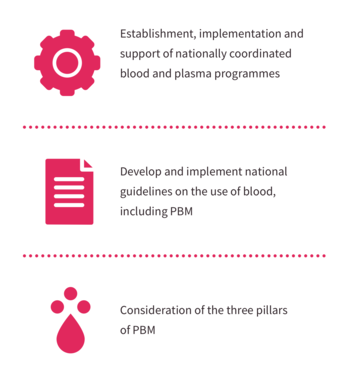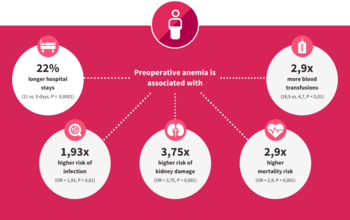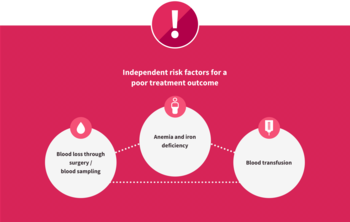What is Patient Blood Management?
"Patient Blood Management is a multi-disciplinary, patient-focussed treatment concept that aims to improve treatment results through the reduction and avoidance of anemia, blood loss and transfusion."
Gombotz H. und Hofmann A. Anaesthesist 2013; 62: 519–527
A medical concept to increase patient safety
The introduction of the three pillars of Patient Blood Management leads to improved quality of care.
Patient Blood Management facts




Systematic blood management for the efficient use of resources
Preoperative or hospital-acquired anemia has a negative impact on the quality of healthcare and outcomes for patients undergoing planned operations. It is therefore crucial to do everything possible to optimise the volume of red blood cells in advance of an operation and to minimise blood loss in hospital so that the patients can get by with their own bodily reserves where possible instead of requiring a blood transfusion.



Implementation process of PBM as standard of care
In order to anchor the integration of Patient Blood Management as a standard of care in the German healthcare system, as recommended by the European Commission, healthcare structures and processes must be adapted to meet the requirements. This demands intensive communication in the public sphere as well as further training in specialist circles, but it will improve the health of the population and save costs in the long term.

Anemia has a negative impact on quality and safety
Anemia is linked to longer hospital stays, surgical complications, higher mortality and the use of blood transfusions.
* Retrospective single-centre cohort study of consecutive patients >18 years old, who underwent a non-cardiac surgery between March 2003 and June 2006. (N= 7,759). It shows the values for variables collected using Propensity Score Matching, which are potential disruptive factors in the relationship between anemia and postoperative mortality. (N=2,090).1
§ Systematic review and meta-analysis of observation studies on correlations between preoperative anemia and postoperative outcomes (24 studies N=949,445).2
† Retrospective cohort study on major non-cardiosurgical interventions in 2008 (prospective validated register of 211 hospitals worldwide, N=227,425). The OR shown contains a comprehensive adjustment for a multitude of clinically relevant variables.3
1. Beattie WS et al. Anesthesiology. 2009;110(3):574–581
2. Fowler AJ et al. Br J Surg. 2015;102(11):1314–1324
3. Musallam KM et al. Lancet. 2011;378:1396–1407
The perioperative risk
Three independent factors increase the risk of a poor operation outcome. However, this risk can be considerably reduced through consistent blood management.


